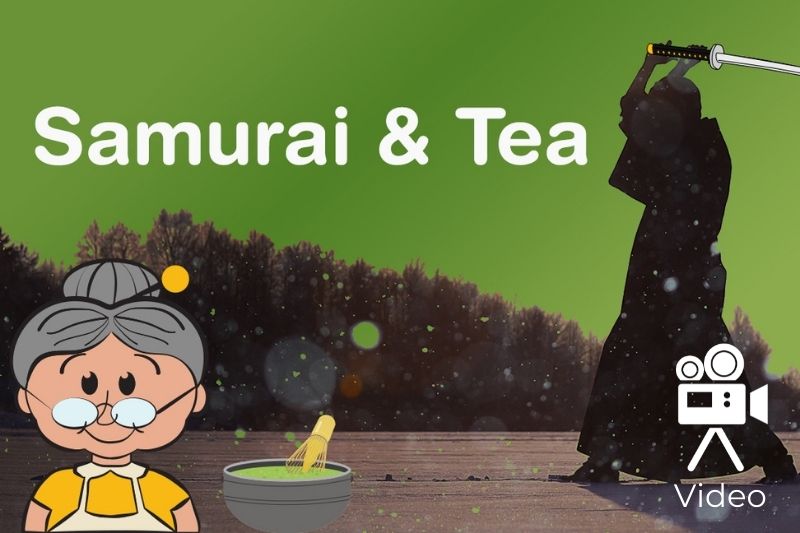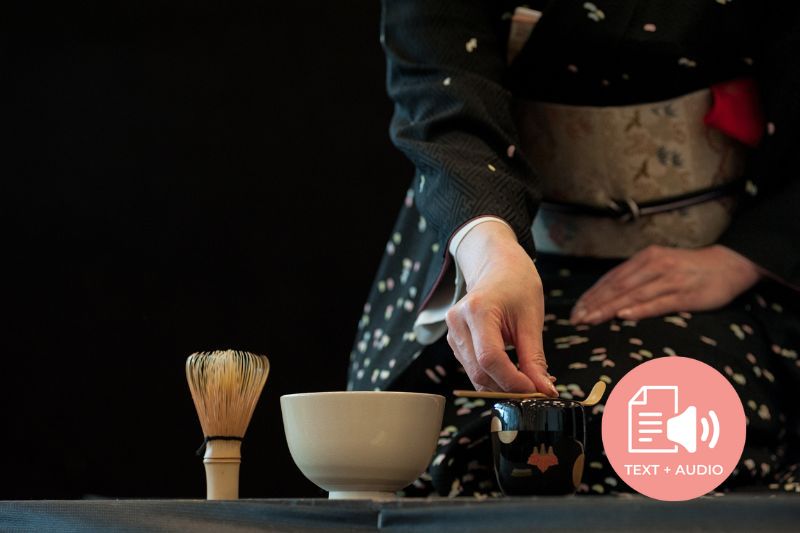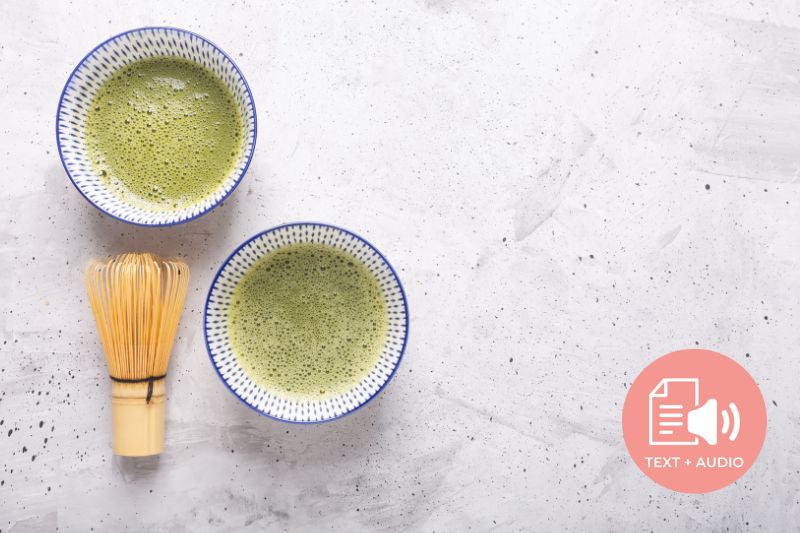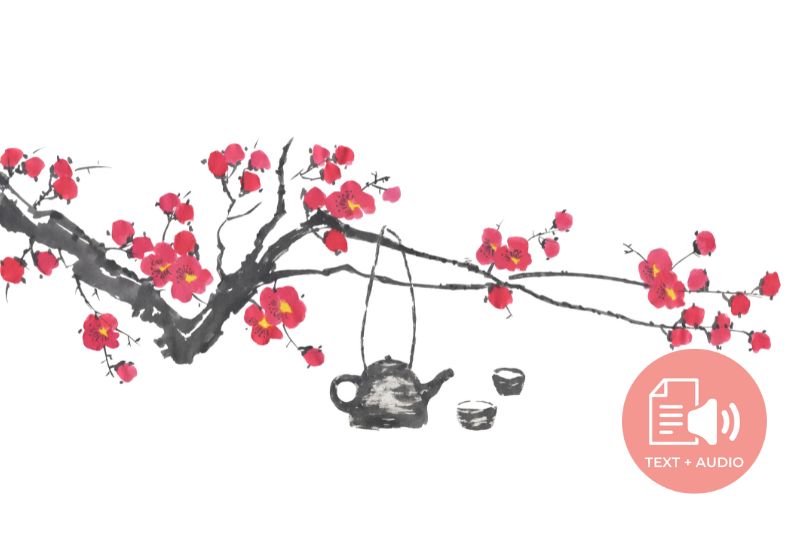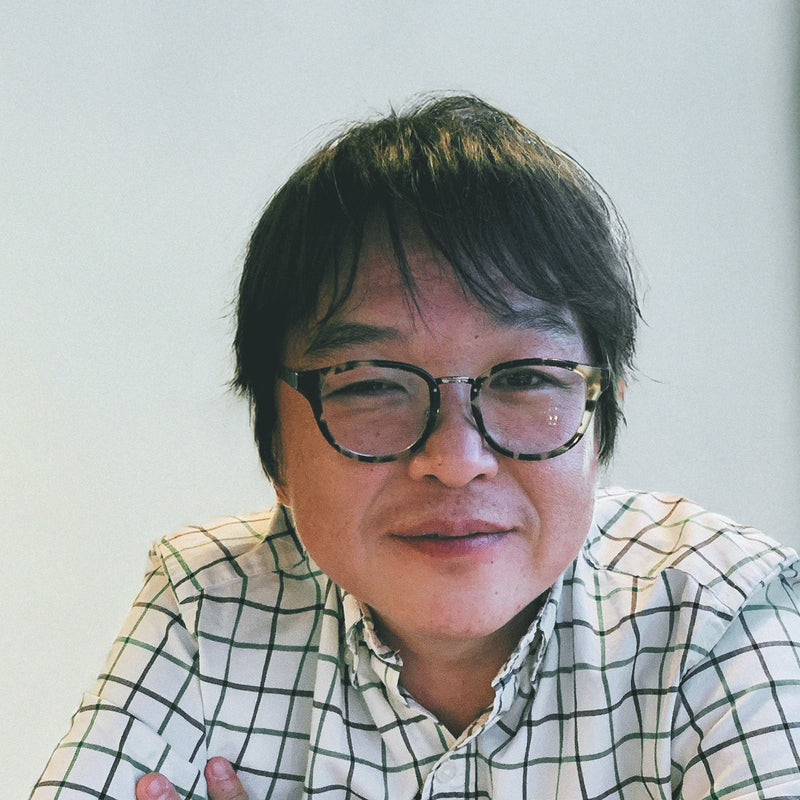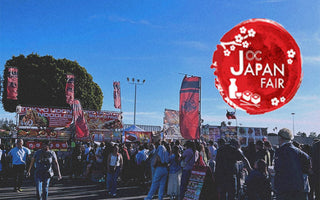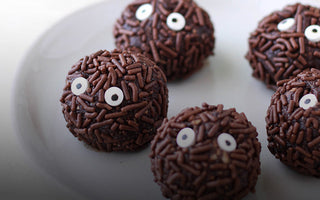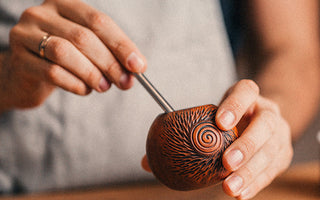The Japanese tea ceremony comes from centuries of tea school teachings and traditions. Its practice is a deep spiritual journey that begins with a simple principle: the sharing of tea is best when the heart is humble and pure.
The tea ceremony is a blend of different arts and tea schools developed over the centuries in Japanese tradition. Its simple focus is to spiritually relish each moment with the knowledge that it will never come again.
Japanese Green Tea Ceremony is called in Japanese
The tea ceremony in Japanese has different names; the most commonly known is "sado" or in direct translation, "way of tea". Another name is Chanoyu, which translates to "hot water for tea". Can it get any simpler than that? But the tea ceremony is an art form of the spirit, embodied in the preparation, service, and partaking of a simple bowl of tea.
A tea ceremony is also known as a "tea gathering". It describes the process from the preparation to the serving of powdered green tea matcha in a beautifully choreographed event. Its process embodies the practical and refined harmony of the arts, architecture, etiquette, and landscape.
From the simple sharing of a tea bowl, Japanese tea ceremony participants share a transformation into mutual generosity, self-awareness, and respect for all things of nature.
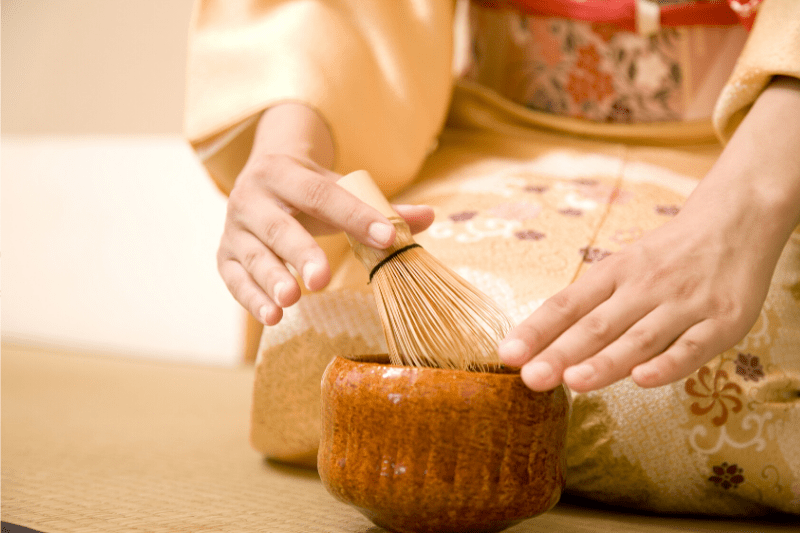
A Tea Ceremony Embodies Centuries of History
Tea was introduced into Japan in about the sixth century. Chinese Zen Buddhists introduced tea to Japan. But it wasn’t until the early 12th century that tea became popular in the country.
A Zen priest named Eisai is credited with introducing the Japanese custom of drinking green tea in powder form. He lived between 1141 and 1215 AD and founded the Rinzai sect of Zen Buddhism during that period.
Eisai had embarked on a pilgrimage to China to study religious writings. When he returned from China years later, he brought powdered tea and tea seeds to the Rinzai temple. Those seeds were planted in the Kyoto hills near the temple where he lived.
Powdered green tea was originally used by the temple priests to stay awake during the customary long periods of meditation. It, therefore, became a temple staple and a Zen ritual for the temple priests.
Over the Years, Temple Ritual Became a Secular Tradition
Over the centuries, what was once reserved only for Zen priests evolved into a secular tradition. Around the fifteenth century, the tea ceremony became a staple in Japan’s culture. A lineage of tea masters developed the practice of the tea ceremony.
-
Murata Shuko (1422–1502 AD): Shuko was a Zen priest credited with merging the secular tradition of the Chanoyu tea ceremony with the principles of Zen.
-
Takeno Jo-o (1503–1555 AD): Jo-o was a tea master credited with refining the steps of the tea ceremony into an art form.
-
Sen Rikyu (1522–1591 AD): Rikyu is the tea master responsible for developing the Japanese tea ceremony principles that we still practice today.
The Tea Master Sen Rikyu (1521-1591) Created the Tea Ceremony Practiced Today
The tea ceremony principles that we celebrate today were established and ratified by the tea master, Sen Rikyu. Rikyu was the son of a merchant. He gained great favor with the 3rd regent of Japan, Toyotomi Hideyoshi, who established Rikyu as his esteemed tea master.
Sen Rikyu, under the authority of the regent, established the principles of the tea ceremony called "wabicha". Wabicha is defined as the style of a simple and humble tea ceremony. The simple character of Rikyu’s tea ceremony continues to be taught and applied wherever a Chanoyu tea ceremony is practiced today.
Wabicha is embodied in the philosophies of Wa, Kei, and Sei Jaku. Wabicha does not just guide the art of the tea ceremony but is intended to be integrated into one’s daily life.

Japanese tea ceremony is an Embodiment of Philosophies
There are four principles embodied in the Chanoyu tea ceremony. Those principles, now four hundred years old, were established by Sen Rikyu. His purpose in refining the tea ceremony was to create a ceremonial art of simplicity and humility. Those philosophies are:
- Wa (Harmony and Peace): This is the principle that one should be in harmony with all. This means being in peace and at one with every element surrounding the ceremony: guest, host, location, environment, nature, etc.
- Kei (respect): honesty, equality, and seriousness between each other. There should be no division of status.
- Sei (purity): to adopt a spirit of purity, one of heart, mind, and body.
- Jaku (tranquility): The adoption of Wa, Kei, and Sei principles should result in an inner peace that allows you to completely share yourself.
Participants Embrace a Tea Ceremony with the Idea of Ichi-go Ichi-e
When we participate in a tea ceremony, it is shared with the principle of “ichi-go ichi-e” (pronounced eecheego eechee-eh). This principle is the concept of “one time, one meeting” and the mindfulness that that one tea gathering is a solitary moment in life, never to be repeated.
With this concept of ichi-go ichi-e, the participants will share a harmonious moment of reverence and spirituality when they share a bowl of tea.
There are Two Types of Green Tea Used – Usucha and Koicha
Two types of green tea called matcha can be used in a tea ceremony. There are also two ways the matcha is prepared, depending on the formality of the gathering. There is a thin tea that is called "usucha", and a thick tea that is called "koicha".
During a Usucha tea gathering, each guest is given an individual tea bowl. In a koicha tea gathering, each guest shares a single tea bowl. The sharing of the koicha tea bowl represents a shared unity of hearts and minds between the guests.
A Chanoyu Tea Ceremony is a Choreography of Purpose & Respect
There is much symbolism and required steps for a tea ceremony. The tea ceremony is about sharing with each other and embodies great symbols of respect.
Preparation by the Host
- The host will send simple invitations to the guests.
- The host will prepare a meal (kaiseki) or sweets to be served with the tea.
- The host will focus on being in harmony with his or her spirit, removing all negativity.
- The host will clean the room.
- The host will simply place flowers in the room (tokonoma).
- The host will place a special carpet (tatami) on the floor.
- The host will announce that guests are welcomed and ready to be received into the tea room.
Preparation by the Guests
- The guest will focus on harmony with his or her spirit and remove negativity from the heart.
- The guests will patiently wait outside the room (shoin) until welcomed by the host.
- The guests will ceremonially wash their hands to remove all dust and dirt from the world.
- The guests will enter the room when welcomed by the host.
- The guests will bow to the host as a sign of respect.
Cleaning the Tea Ceremony Tools
- The host cleans the teaware and tools in front of the guests with a graceful posture so that it is beautiful to watch.
- The host places the tea items in an artistic and beautiful fashion.
- All participants are silent, focused on the harmony and beauty of the choreography.
Preparing the Matcha Green Tea
- The host prepares the tea by placing matcha into the bowl and adding to it a small amount of hot water.
- The host whisks the matcha and water with a soft bristle to make a paste.
- The host adds more hot water to make the tea.
- The host serves the tea, as described below.
Serving the Matcha Green Tea
- The host chooses the most beautiful side of the bowl, referred to as the front."
- The host passes the tea bowl, front-facing, to the guest.
- The guest receives the tea bowl and admires its beauty.
- The guest turns or rotates the tea bowl so that the front faces the host (the guest never takes a sip from the front of the tea bowl).
- If the tea bowl is to be shared, the guest wipes the rim and passes the bowl to the next guest in the same fashion, until all have partaken of the tea.
Final Stage of a Chanoyu Tea Ceremony
- The host cleans and rinses the teaware and utensils.
- The guests inspect the items as a symbol of respect to the host, examining the tea items with a soft cloth.
- The guests return the tea items to the host.
- The host puts the tea items back in place aesthetically.
- The guests bow to the host and leave the room as a sign of respect for the host.
The tea ceremony is concluded.

I Have Some Japanese tea ceremony Trivia Facts for You
- Chanoyu is literally translated as "hot water for tea".
- Only green tea matcha is used during a tea ceremony.
- The tradition of drinking matcha first began with temple monks to keep them awake during long evening meditation.
- Green tea was originally medicine. Japanese green tea experts still call it a "dose".
- The traditional Japanese tea ceremony has existed for over 400 years.
- Originally, a tea ceremony was practiced only by men.
- Today, a tea ceremony is practiced mostly by women.
- The Chanoyu tea ceremony’s guiding principles were perfected during the Sengoku period, an especially violent era in Japanese history.
- A tea ceremony can last upwards of four hours.
- Longer tea ceremonies involve a multi-course meal (kaiseki).
- Mystery surrounds why the 3rd Japanese regent, Toyotomi Hideyoshi, compelled Sen no Rikyu to commit hara-kiri (seppuku) on April 21, 1591.
- Four things should be taken to a tea ceremony:
-
a kaishi (paper to place your sweets);
-
a youji (a small knife to cut your sweets);
-
a kobukusa (cloth to hold your tea bowl); and
-
a sensu (fan); a fan oftentimes scented with oils to permeate the air
A tea ceremony can happen at any time of the year. Whether it is a celebration of usucha or koicha depends on the seasonal period or time of day it is held. If the intent is to honor a specific occasion, then it can embody a combination of forms for the event. Regardless of the celebration, Chanoyu’s principles guide the tea ceremony.
A tea ceremony encourages the participants to rise above the ordinary and uncover the hidden meaning within objects, art, spirit, fellowship, and nature. It embodies peace and harmony between participants. Don’t you wish our world leaders could aspire to sit down and share the principles of a tea ceremony?
Get Free Bonus Books
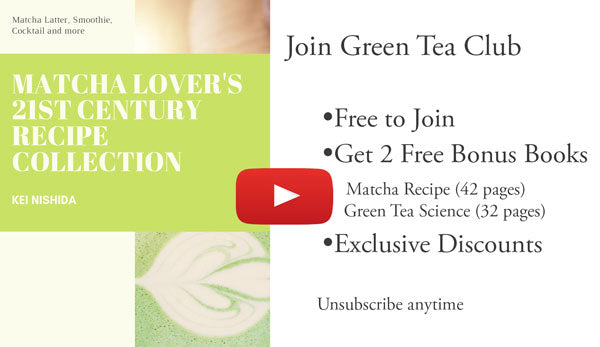
Sign up for free to the Green Tea Club to get advice and exclusive articles about how to choose Japanese Tea, and tips, tricks, and recipes for enjoying Japanese tea.
About the author
Kei Nishida
Author, CEO Dream of Japan
Certification: PMP, BS in Computer Science
Education: Western Washington University
Kei Nishida is a passionate Japanese green tea connoisseur, writer, and the founder and CEO of Japanese Green Tea Co., a Dream of Japan Company.
Driven by a deep desire to share the rich flavors of his homeland, he established the only company that sources premium tea grown in nutrient-rich sugarcane soil—earning multiple Global Tea Champion awards.
Expanding his mission of introducing Japan’s finest to the world, Kei pioneered the launch of the first-ever Sumiyaki charcoal-roasted coffee through Japanese Coffee Co. He also brought the artistry of traditional Japanese craftsmanship to the global market by making katana-style handmade knives—crafted by a renowned katana maker—available outside Japan for the first time through Japanese Knife Co.
Kei’s journey continues as he uncovers and shares Japan’s hidden treasures with the world.
Learn more about Kei
